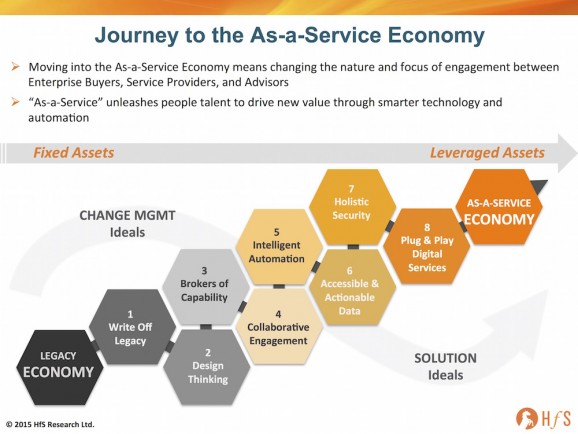Last week, the HfS Leadership team went all in on the 2016 NASSCOM Industry Leadership Forum (ILF) in Mumbai with 4 presentations and panels, dozens of meetings with industry leaders from providers and clients, multiple media interviews and local delivery center visits thrown in for good measure. So myself and Charles Sutherland jotted down our thoughts as we fought off the lurking jet-lag demons on our way back to the States yesterday…
 Most refreshing this time around, has been the toning down of the rhetoric and hype, as most of the providers tackle the winds of change threatening a worrying decline of growth in the global services industry.
Most refreshing this time around, has been the toning down of the rhetoric and hype, as most of the providers tackle the winds of change threatening a worrying decline of growth in the global services industry.
From this year’s proceedings, we have taken to heart the near ubiquitous discussion of “Digital enablement and Disruption” to construct a sentiment analysis of where the stakeholders in ILF currently find themselves in their transition from a world of legacy operations to delivering what HfS has termed the “As-a-Service Economy”.
From enthused to unsettled, service providers sober up as reality sets in
In a word, we felt the sentiment of the ILF sessions in 2016 is best described as the global IT services industry being “unsettled”. Last year, we saw the pervasive adoption of “Digital” as the driver of future growth for every service provider at ILF, with a different definition in every instance as to what it meant. The ILF sentiment in 2015 was “enthusiastic” in a word. Over the the course of the past year, we believe most of the service providers are awakening to the degree of change necessary to move to a new model that delivers Digital value based on technical capable offerings, untethered to huge incremental headcount investments.
While seeing some early client successes, most smart service providers are also questioning whether each is as differentiated in their capability and messaging as they believed a year ago. It is becoming abundantly clear, as the industry wakes up to the reality of what is really needed to evolve to the As-a-Service economy, that the differentiation points between service providers has become blurred – and being able to demonstrate true distinctiveness and differentiation from each other has become a very difficult task.
If in 2015, every service provider at ILF wanted to brief HfS on the excellence of their Digital offerings, in 2016 the conversations were inquiries, seeking to test the efficacy of a service provider’s messaging against that of competitors and against buyer requirements and expectations.
Six Factors causing this “State of Unsettlement”
So what has caused this change to a State of Unsettlement, amongst the service provider community in just 12 months? In short, we believe it has been a mix of six factor factors, namely:
- A rise in global economic uncertainty, exacerbated by the instability of the Brazilian, Russian and Chinese economies, record oil price lows, a volatile and unpredictable stock market globally and the creeping threat of deflation;
- The rise of new “born in the cloud” competitors, such as: Aason, Bluewolf, Equiniti and OneSource Virtual which can offer significantly more cost effective solutions and different delivery models;
- The increasingly viral adoption of Intelligent Automation in service delivery;
- A recognition that Digital is not just a supplemental technology spend to the legacy business, but a fundamental change in how the underlying business model operates (for clients and for service providers);
- The increased relevance and disruptive competitiveness of nimble mid-sized service providers (IT and business process) that can scale up and down aggressively to win deals, based on client needs and their own intentions to invest in the future model, such as EXL, Genpact, Hexaware and Virtusa;
- Increasing engagement with mid-market clients, which frequently have requirements as complex as the high-end, but cannot spend anything like the same amounts. Many of these clients will form the FORTUNE 500 of the future and most traditional service providers are simply not equipped to take these clients on profitably with their current delivery models.
We believe these six factors are culminating to provide a growing recognition of the level of change required in sales, solutioning and delivery, in order to achieve or maintain market leadership in the emerging As-a-Service Economy.
Why the Global Services industry must align to the Eight Ideals of As-a-Service as to find its path to a Digital Future
We came to this view after we analyzed all of our discussions during the week with the lens of the HfS Ideals of the As-a-Service Economy. These Eight Ideals – as shown in the following exhibit – are the necessary change management and solution capabilities required to succeed in this new world.
These Ideals resonate with leaders of both service providers and enterprise clients, looking for a way to understand the path that needs to be followed to succeed in the future. Yet, their adoption is not a binary achievement. No existing service provider suddenly executes against an Ideal at the flip of a switch, however much that might be wished. Instead, it is a journey of change and internal transformation as these Ideals are often dramatically different in nature and intent from what has previously created success in IT and business process delivery for the last few decades.
There are nuances to the realization of these eight Ideals across the different service providers, which all demonstrate varying vertical and horizontal capabilities. In short, no service provider can boast they are “all things to all people” like so many claimed in days gone by, but instead they need to focus on those areas where they can be truly distinctive and have real capability to take their clients to the As-a-Service promised land.
This sense of unsettlement at ILF 2016 comes down our recognition that the leading service providers are still very much swimming in a state of transition towards achieving these Ideals. Every one of these Eight Ideals formed part of the discussions on service provider strategies and investments, however, the depth and breadth of client experiences to-date against each Ideal is still very much at an early stage. Hence, the level of inquiry and intrigue form service providers as to how they were faring against each other, and how to make each Ideal more extensive in the year(s) to come.
Why we view Intelligent Automation and Design Thinking as the initial critical ideals to address
This was the first NASSCOM event, or any services industry event for that matter, where we had experienced a genuine atmosphere of honesty and humbleness that the winds of change are upon us and real shifts and investments need to occur for healthy industry growth to continue. There was a wide recognition that simply focusing on driving down costs and selling more aggressively will become futile as those service providers, which can genuinely decouple headcount from delivery, and can scale their offerings to suit the needs of clients of all sizes, will take over the leadership of the market.
The two main Ideals we believe service providers must urgently address over the course of 2016:
1) Intelligent Automation. Automation, coupled with offshore delivery, is the future of the industry and the only true way to decouple labor costs from scaling service delivery. Having a more automated offering allows service providers to take on the emerging mid-market deals more profitably. It also allows incumbent service providers to defend client contracts at the high-end, where the threat of disruptive competitors offering large efficiency savings through automation is emerging in an increasing number of competitive contract renegotiations. In addition, those service providers with great confidence in their automation capabilities, will be the most successful at stealing business from legacy incumbents failing to do enough to protect their existing contracts when they come up for renewal.
2) Design Thinking. The biggest single issue with today’s services relationships is the fact that only 20% (see link) are considered “collaborative” by clients. However, both the C-Suite and middle management recognize (see link) that having joint creative problem solving and “Design Thinking” with clients is a real way forward to embrace the Ideals of As-a-Service.
It is our firm belief that if service providers and clients can embed the principles of Design Thinking into their relationships, they will quickly become more collaborative in nature, and both buyer and service provider can really begin working together in earnest to achieve common goals and business outcomes. In short, As-a-Service is about a business model transformation – and how it can be empowered by Digital technology, made more effective and Intelligent by Automation and Cognitive Computing, made possible by smart change management and made trustable by proactive security deployment. Hence the need to design this seismic change, in terms of both talent and solutions, is what holds the keys to the promised kingdom.
Design Thinking is helping several relationships inject lateral thinking and renewed motivation to work together, not only in the customer-facing front office, but also in the back office operational functions. Design Thinking in services is based, primarily, on both service buyer and provider coming together to create business outcomes that are mutually beneficial – and motivational – for both parties. However, this must be established as ongoing collaboration across all key relationship stakeholders, and not simply two days of senior management putting sticky notes on each others’ foreheads. There must be senior pressure and buy-in to adopt Design Thinking as a means to move away from Six Sigma-obsessed old world models, and really change the way the service buyer and provider teams work together.
The Bottom-line: What to watch for in 2016
We firmly believe 2016 will be the year in which both Intelligent Automation and Design Thinking come to the forefront of the sourcing and services market. It will be the year when service provider leadership teams are sent to design camps, and a whole new set of conferences and workshops will feature Intelligent Automation and Design Thinking as their theme of the moment. Some of this may be hype, or even unnecessary, but at the root of it, the arrival of Intelligent Automation and Design Thinking into the mainstream of the IT and Business Process services world makes sense to us as a way to re-imagine more effective process-based solutions for this increasingly digitized As-a-Service world.
Further out, we really see the development of solutions comprising more Ideals of As-a-Service, most notably advances in predictive analytics for Accessible and Actionable data, Holistic Security and cognitive computing extensions to Intelligent Automation as providers and buyers seek the ultimate nirvana of Plug-and-Play Digital Services, but we firmly believe that Intelligent Automation and Design Thinking are the major Ideals to help write-off the legacy of the past and prepare for the value that is possible to attain in the future.
Posted in : Business Process Outsourcing (BPO), Cognitive Computing, Design Thinking, Digital Transformation, HfSResearch.com Homepage, IT Outsourcing / IT Services, Outsourcing Events, smac-and-big-data, Sourcing Locations, sourcing-change, The As-a-Service Economy









Good feedback, Phil. No doubt the development and even implementation of Automation and Design Thinking happens this year.
Surely – when each contract is rolled over – providers with A & DT initiatives will compete based on turnaround and accuracy rather than on price. They’ll pay down their initiatives, push their CoE’s into the black by charging out to the rest of the provider firm, and will start dropping price only when absolutely necessary (beginning in 2 years).
Those with few initiatives in pipeline will have fast ebbing returns by end-2017. And the universe of major providers bifurcates.
Excellent analysis, Phil and Charles! There is definitely a new wave of concern as to how Indian firms need to approach the new economy. The old model with a “Digital Wrapper” is not the solution.
Phil,
What a strong write up, this really captures where we are as an industry. I would add a 7th factor – those desperate legacy providers promising deals at extremely low prices, which they will struggle to deliver. This is a rampant issue we are seeing of late, where this desperation to win deals is hurting the more forward-thinking providers trying to develop digital offerings and a more strategic relationship with the client. We are witnessing the old model providers holding back the industry to protect their legacy business models,
Chris
@Chris – we were tempted to title this piece “Digital Desperation” as you are indeed correct in your observation here. However, I don’t think we’ve yet reached the panic button stage, more of a “what the heck do we do next to break this cycle of uncertainty” stage…
PF
Superb Analysis Phil as always.
I completely agree with you that Digital is still remains a hyped word for some if not most enterprises today. I clearly recall a mid tier Offshore tech CEO making a public comment a few months back that if he did not use the word Digital in his communication, no body would listen to him.
Offshore techs have to realize that they need to evolve to the changing business requirements…
Sounds like the journey from the good times to the difficult times to the uncertain times has been completed; the mood has shifted too, from optimism to apprehension to disbelief (as the negative rates will begin to be reported by some). Seems like the picture will remain grey for the forceeable future, despite an occasional cheer or two of course. This period now and ahead will almost mirror the global economy (that has transversed a similar curve of unpredictability?) and will last as long as it takes for the industry (and consumer) transition to ‘digital’ completes – only by then will the next wave of productivity, new tech-led economy growth bring the old services momentum back.Today”s large IT and BPS firms are still tuned to industry 2.5, than being aligned to deliver on 4.0 needs…surely the age of Uncertainty and Unsettlement is well upon us.